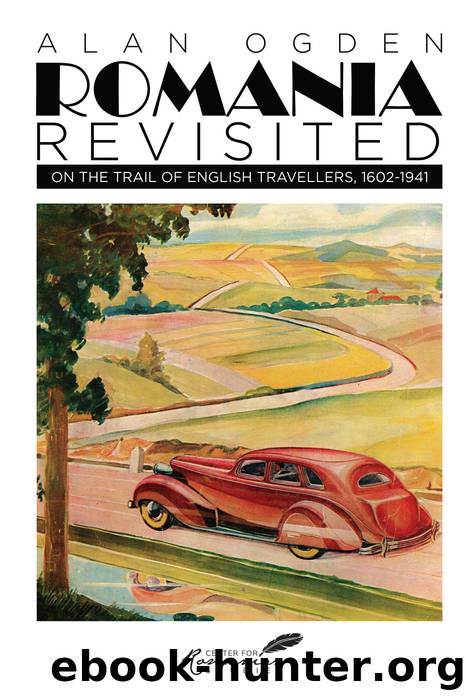Romania Revisited: On the Trail of English Travellers, 1602-1941 by Alan Ogden

Author:Alan Ogden [Ogden, Alan]
Language: eng
Format: epub
ISBN: 9789739432054
Publisher: Histria Books
Published: 2022-09-15T00:00:00+00:00
1 Round about the Carpathians (1878).
2 Roumania, the Border Land of the Christian and the Turk, 1888.
3 Another source states this is a punishment for adultery.
4 Transylvania: its People and its Products, 1865.
5 From Stanleyâs Rouman Anthology, 1856.
6 Wonderfully captured on camera by Kurt Hielscher in 1931.
7 Operation Autonomous, 1988.
8 Liane Jones, A Quiet Courage, 1990.
Chapter Eleven Houses and Gardens in the High Carpathians
It was mid-night when I reached BraÅov where Emily Gerard1 had found
in the streets, beside the usual contingent of fiery Magyars, stolid Saxons, melancholy Roumanians, ragged Tziganes and solemn Armenians, other figures, red-fezzed, be-turbaned, or long-robed⦠only a few steps from such things as camels, minarets and harems.
Pagetâs2 description of BraÅov was similar though more flowery:
The sober plodding Saxon is jostled by the light and cunning Greek; the smooth-faced Armenian, the quaker of the East, in his fur coat and high kalpak, meets his match at a bargain in the humble-looking Jew; and the dirty Boyar from Jassy, proud of his wealth and nobility, meets his equal in pride in the peasant noble of Szeckler-land. Hungarian magnates and Turkish merchants, Wallach shepherds and Gypsy vagabond make up the motley groups which give life and animation to the streets.
Emily also told a story of how in the fourteenth century church, where there was a collection of the most exquisite Turkish carpets, an Englishmen stayed an entire month trying to buy âthat pale-blue one up yonder.â
Sitwell3 described it as
a pleasant town with most of the character removed from it owing to the Austrian rule, which has left large public buildings in the manner of those to be found all over the Hapsburg Empire. This might be Graz or Klagenfurt or Linz⦠the chief sight of BraÅov is the Black Church, built in German Gothic by the Saxons and called by that name because of its walls that are stained with smoke. Its Protestant interior is rather bleak and uninteresting, though there are some good oriental or Turkish rugs, of a pattern which is said to have been made especially for export to the Saxons of Transylvania. Apart from the shops and the Black church, there is but little of interest at BraÅov.
I found this description as accurate today as it was in its time and sadly did not experience Emilyâs sense of the Levant. Andrew Crosse4 rather priggishly observed in BraÅov:
The Wallach maiden is adorned by her dowry of coins hanging over her head and shoulders, and with braids of plaited black hair â mingled, I am afraid, with tow, if the truth must be spoken.
Charles Boner at BraÅov, to his astonishment, found âEnglish bricklayers were at work, and everyone told me of the astonishment which their quickness occasioned⦠one gentleman said he had counted that they laid six bricks whilst the native workman laid one.â5
South of BraÅov, in the mountains, is the Castle of Bran, granted by Ludovic I DâAnjou to the good burghers of Bran to defend the southwest approaches to the city. Before the pass at
Download
This site does not store any files on its server. We only index and link to content provided by other sites. Please contact the content providers to delete copyright contents if any and email us, we'll remove relevant links or contents immediately.
Spell It Out by David Crystal(36037)
Underground: A Human History of the Worlds Beneath Our Feet by Will Hunt(12022)
A Year in the Merde by Stephen Clarke(5323)
Venice by Jan Morris(2523)
Claridge's: The Cookbook by Nail Martyn & Erickson Meredith(2359)
My Paris Kitchen: Recipes and Stories by Lebovitz David(2254)
A TIME OF GIFTS by Patrick Leigh Fermor(2152)
The Plantagenets by Dan Jones(2036)
Welcome to the Goddamn Ice Cube by Blair Braverman(1990)
The Finnish Way by Katja Pantzar(1933)
From Russia with Lunch by David Smiedt(1927)
Top 10 Prague (EYEWITNESS TOP 10 TRAVEL GUIDES) by DK(1926)
Bang Poland: How To Make Love With Polish Girls In Poland by Roosh V(1920)
The Isle of Mull by Terry Marsh(1892)
A TIME TO KEEP SILENCE by Patrick Leigh Fermor(1862)
Rick Steves London 2018 by Rick Steves & Gene Openshaw(1822)
Insight Guides Experience Tokyo by Insight Guides(1814)
A Taste of Paris by David Downie(1810)
Merde in Europe by Stephen Clarke(1724)
